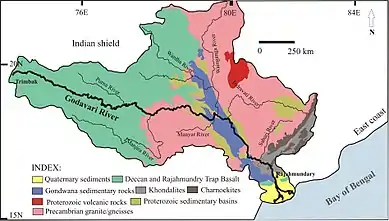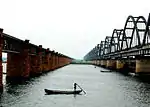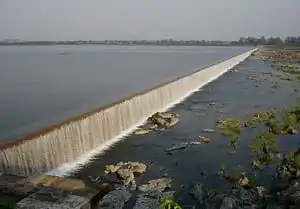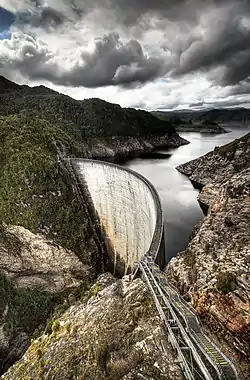Dowleswaram Barrage
The Dowleswaram Barrage was an irrigation structure originally built in 1850 on the lower stretch of the Godavari River before it empties into the Bay of Bengal. It was rebuilt in 1970 when it was officially renamed the "Sir Arthur Cotton Barrage / Godavari Barrage".[1]
| Sir Arthur Cotton Barrage / Godavari Barrage | |
|---|---|
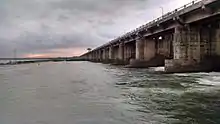 | |
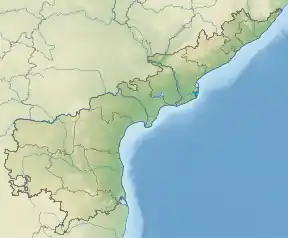 Location of Sir Arthur Cotton Barrage / Godavari Barrage in Andhra Pradesh | |
| Country | India |
| Location | Rajahmundry, East Godavari district, Andhra Pradesh |
| Coordinates | 16.9307594°N 81.7657988°E |
| Purpose | Irrigation & Water supply |
| Status | Operational |
| Construction began | 1850 |
| Opening date | 1970 |
| Owner(s) | Government of Andhra Pradesh |
| Dam and spillways | |
| Type of dam | Barrage |
| Impounds | Godavari River |
| Length | 3,599 m[1] |
| Website irrigationap | |
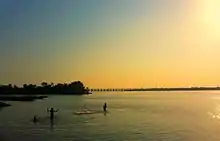
Geography
The Godavari River empties its water into the Bay of Bengal after flowing nearly fifty miles from the Dowleswaram Barrage. Rajamahendravaram is a city situated on the left bank of Godavari River. Upstream, where the river is divided into two streams; the Gautami to the left and the Vasistha to the right, forms the joining line between the West Godavari and the East Godavari districts. The dam alignment crosses two mid stream islands.
Original Dowleswaram Barrage
The original Dowleswaram Barrage (also spelled Dowlaisweram or Dowlaiswaram) was built by a British irrigation engineer, Sir Arthur Thomas Cotton and completed in 1850.[2] The barrage was constructed in four sections, which allowed flood passage during the construction period. The Dowleswaram Barrage was 15 feet high and 3.5 km long.
Cotton's many projects averted famines and stimulated the economy of southern India. Before this barrage was constructed many hectares of land has been flooded with water and was unused. The water would be worthlessly going into sea. But when Sir Arthur Thomas Cotton had built the barrage those unused lands were brought into cultivation and the water was stored and used. The Cotton Museum was constructed on behalf of Cotton's memory. It is a tourist attraction in Rajahmundry.
Modern Sir Arthur Cotton Barrage / Godavari Barrage
In 1970, the barrage was heightened to 10.6 m. The reservoir has 3.12 Tmcft gross storage capacity and dead storage of 2.02 Tmcft at 40 feet (12 m) MSL.
See also
References
- "Sir Arthur Cotton Barrage / Godavari Barrage B00131". Retrieved 31 March 2016.
- Hope, Elizabeth (1900). General Sir Arthur Cotton, R. E., K. C. S. I.: His Life and Work. London: Hodder and Stoughton. p. 120. ISBN 978-1444629965. Retrieved 26 December 2018.
dowleswaram.
| Wikimedia Commons has media related to Dowleswaram Barrage. |

